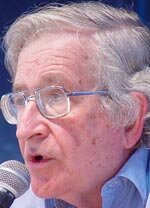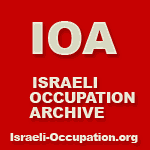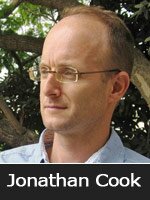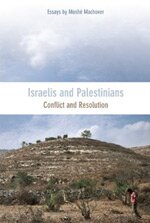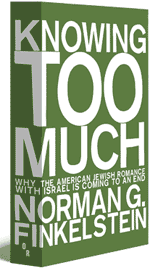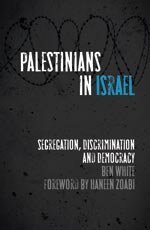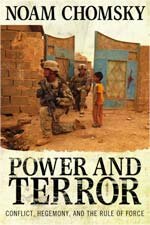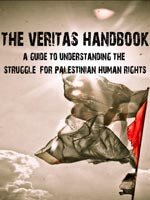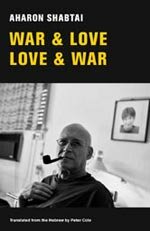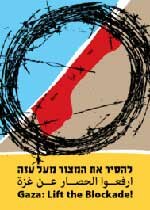By Amy Kaplan, The Chronicle of Higher Education – 7 Nov 2010
http://chronicle.com/article/In-Palestine-Occupational/125246/
Ramallah, West Bank
It’s late May, and I’m sitting in a stylish apartment furnished with Palestinian antiques, dining with colleagues from Birzeit and Al-Quds Universities. They’ve studied and worked in Paris and New York, Amman and Cairo; next week they have meetings in Geneva and Berlin. And yet, they cannot travel nine miles to conduct research in a Jerusalem archive, and they cannot meet in person with scholars from universities in Gaza. When, next week, my dinner companions leave the country, they will not fly from Ben Gurion International Airport in Tel Aviv, less than 20 miles away; they will instead need an extra day to drive to Amman, and will worry the whole time that they are gone that they won’t be allowed to cross the border into the West Bank when they return.
I spent 12 days driving back and forth between my hotel in East Jerusalem and universities in the West Bank. On each trip I waited at a military checkpoint along Israel’s security wall to have my passport inspected. One thing became immediately clear: Freedom of movement is fundamental to intellectual life. How can ideas and speech circulate freely if teachers and students cannot? In my encounters with Palestinian academics, I was struck both by the obstacles that living in the occupied territories imposes on their mobility, and the creativity that allows Palestinian intellectual life to be so vibrant today.
I traveled to Palestine to participate in the first faculty-development seminar sponsored by the Palestinian American Research Center. Backed by a State Department grant, the seminar aimed to connect American and Palestinian academics, and to introduce us to Palestine as a subject for research and teaching. The PARC group consisted of 10 scholars representing a variety of disciplines: communications, history, literature, philosophy, social psychology, and social work. We visited universities, toured cultural centers, attended seminars at think tanks, and met with Palestinian intellectuals from academe, NGO’s, and the arts.
I applied to the seminar because I am writing a book on Zionism in American culture. I want to understand how America’s overriding public support of Israel and popular identification with Zionism developed and changed over time. I have some intuitive assumptions about what John F. Kennedy called the special relationship between America and Israel, but I know very little about Palestine or the relationship between Americans and Palestinians, which needs to be part of my story.
A year ago, I attended an international conference in Jerusalem. The topic was Herman Melville, who traveled to Palestine in the 1850s and wrote a long epic poem about his journey, Clarel: A Poem and Pilgrimage in the Holy Land. From Melville I learned about the 19th-century evangelical zeal for gathering Jews in the Holy Land, decades before the rise of political Zionism. Melville painted Palestine through the prism of America’s westward expansion. He compared Arabs to American Indians; one of Melville’s characters is a pioneer of Puritan ancestry who converts to Judaism and takes literally the messianic words that conclude the Passover Seder, “Next Year in Jerusalem.” To the chagrin of his Jewish-American wife and daughter, he moves them there. As part of the conference, I traced Melville’s footsteps to Bethlehem, the Dead Sea, and Jaffa.
I was eager to return to Palestine, to see what Edward Said called “Zionism from the standpoint of its victims.” The Palestinians I met, however, did not only identify themselves as victims but also as cosmopolitan intellectuals struggling to build a civil society in which the university plays a central role. I felt a sense of familiarity with the international academic style of my Palestinian counterparts, until I would hit a wall thrown up by the strangeness of sustaining an intellectual life under such confining conditions. Our campus visits highlighted state-of-the-art science labs and newly equipped gyms. Then our hosts would begin to recount the mortal dangers Palestinian students and faculty face in pursuing higher education.
At Hebron University, we gathered by the gates at a memorial for three people killed by Israeli settlers in 1983. Not lingering there, we were ushered through bright new buildings to meet with the president of the university. Calling education a “human right,” he boasted about the academic accomplishments of the largely impoverished student body—70 percent of whom are women. The vice president of external affairs, an English professor who studied in Atlanta, said that the university seeks to create an American-style campus environment, and he expressed frustration that all classes and activities must end by 4 p.m. to accommodate the long journey home through military checkpoints and occasional roadblocks.
The following day we traveled to Bethlehem University. The campus has a pastoral feel with limestone buildings and lush trees in full bloom. We visited a beautifully restored Roman Catholic chapel, and then went to the library. There my gaze was drawn to an irregularly rounded window, a hole made by an Israeli rocket in 2002, during the siege of the Church of the Nativity. Rather than repair the damage completely, the university preserved it as a window on the floor where the Palestinian Heritage Center is housed. Our guide boasted that since the university opened in 1973, classes have been held continuously—on and off the campus—despite being ordered to close 12 times by the Israeli military. (The longest of these closures lasted for three years.)
University closures were a way of life in the West Bank and Gaza during the first and second intifadas, between 1987 and 1993 and 2000 and 2006. Some closures lasted as long as five continuous years. Between 2001 and 2003, a military road block severed the Birzeit University campus from the city of Ramallah, where most of its staff and faculty live. The Arab American University at Jenin had the dubious distinction of opening the same day that the second intifada broke out, which made it impossible to start classes. On every campus, I heard stories of violent disruptions, though the emphasis was always on the daring efforts to keep education alive: Classes were held in private homes, mosques, and churches, even though this was illegal according to military law. By the time of the second intifada, the Internet allowed for “long distance” learning, although in Palestine, distance is never merely a matter of geography.
In Jenin and Nablus we drove through glistening new campuses, where students seemed preoccupied by final exams and summer vacations. At a meeting with deans at Birzeit, however, we did hear about how restrictions on movement—both from outside and within the territories—are creating hardships. Palestinian universities do not yet have the resources—or the political stability—to grant doctoral degrees, so they rely on the outside world to train faculty members. Many students complete their bachelor’s and master’s degrees in Palestine and then go abroad for their Ph.D.’s. The universities draw heavily on professors with foreign passports, many from the Palestinian diaspora. Yet it has been increasingly difficult for these scholars to get visas, and even harder to renew those visas after their three-month term expires, when visitors can apply for renewal only after leaving the country. At Birzeit, an assistant professor in the history department had just been denied re-entry—in the middle of the semester. At An-Najah National University, in Nablus, the semester length has been tailored to accommodate foreign students and faculty on three-month tourist visas. The unpredictability of the visa process makes planning and hiring difficult and demoralizing.
The problem was brought home when I was planning to meet a literary scholar from Al-Quds University, one of the organizers of the Melville conference. He canceled by e-mail, explaining that he couldn’t meet me in Jerusalem because he had been denied re-entry at the Jordan border four weeks ago—before the end of the semester. In addition to the “unfairness and the debilitating effects,” he wrote, there was the problem of getting physical possession of his final examinations to grade.
Internal restrictions on movement are also altering the composition of the student body at Palestinian universities. Birzeit sees itself as a national university, and it used to draw students from all over Palestine. But in the last 10 years, the number of students from Gaza has dropped from a quarter of the population to none. In addition, fewer students are willing to endure checkpoints and curfews to travel from the north and the south of the West Bank to Ramallah. Birzeit, like every university in the West Bank, is becoming a regional institution. Faculty who studied at Birzeit years earlier lament that it is no longer a place where students from Gaza, Jerusalem, Ramallah, Hebron, and Jenin can forge lasting ties.
Palestinian students from Gaza are banned by the Israeli military from studying anywhere in the West Bank. At Bethlehem University, our host related the recent case of a senior who, at what might have been a routine stop at a checkpoint, was taken by Israeli soldiers when they saw her identity card from Gaza. They immediately blindfolded and handcuffed her and deported her to Gaza. Despite interventions on the part of the Vatican and Israeli human-rights groups, the High Court of Justice upheld her deportation.
At the Institute for Palestine Studies in Ramallah, we attended a roundtable discussion on “Research Challenges in Palestine.” Like academics everywhere, Palestinians are gifted in the art of kvetching, and they shared familiar plaints—students aren’t receptive enough to critical thinking; the outside world doesn’t appreciate us enough. One writer complained that the arts are not valued by society; a social scientist lamented how politicians don’t take research into account when they are setting policy.
And so it went, until a professor of political science interjected: “Let’s not forget who we are and what we are doing. We are under occupation.” The Palestinian Authority “is under occupation and economically tied to Israel,” he continued. “Budgetary issues are linked to Israeli needs. We are divided from Gaza. And our future is unknown. Research requires resources, support, and independent institutions. We don’t have these fundamentals, which leaves us with fragmented agendas.”
A literature professor responded with equal fervor: “We don’t like to blame ourselves, but we can’t blame everything on occupation. We haven’t made it a priority to build a critical research center at any of our universities. Israel is to blame, but so are we.” As the conversation went back and forth, I felt like I was eavesdropping on a well-worn argument.
Finally, a historian changed the subject. No Arab states have opened their archives on Palestinian-related matters, he complained, noting that Jordan in particular has not preserved key documents and registers from the time the West Bank was under its control—a process he decried as “ethnocide.” When a member of the PARC group asked about the relationship between historical research and national identity, a Palestinian responded that one of the Palestine Liberation Organization’s first efforts in the 1960s was to create the Palestine Research Center in Beirut. In 1982, this well-respected collection filling eight floors was ransacked by Israeli troops and their Lebanese allies. Though most of the collection was later returned, the Center took more than a decade to start functioning again. Another scholar pointed out that Jerusalem has a trove of archives in church libraries and private collections, but that most of those are off limits to Palestinian researchers from the West Bank.
The lack of access to archives has forced Palestinian historians to approach the past through alternative channels, and oral history has emerged as a crucial source of knowledge, as have collections of photographs. Oral-history projects seemed to be booming at many of the institutions we visited. The Palestinian Association for Cultural Exchange, founded in 1996 “to protect and promote Palestinian cultural heritage,” has been developing a detailed oral-history archive. When we arrived at An-Najah National University, in Nablus, we were given an English publication of interviews done by M.A. students with local refugee-camp inhabitants, who in 1948 had fled their homes from areas now inside Israel. The editor of this collection spoke eloquently about the “need of people under occupation to craft their identity.” He stressed the necessity of preserving the stories of a generation that is passing away. Together these archives affirmatively answer the question raised by one of the participants: “Is there a Palestinian collective memory?”
The social scientists at the roundtable, more concerned about the present, raised the question of who was setting the agenda for their research. One participant from Birzeit complained about the “NGO-ization” of research: As money pours into Ramallah—which someone jokingly referred to as the “Green Zone”—from the European Union, the United Nations, and the United States, research plans are too often determined by outside financing agencies. Grants are often tied to political agendas and preconceived ideas about Palestinian society.
When an American social psychologist asked whether there were polls of the local population, the Palestinians laughed. “We are the most studied people in the world,” one of them said. The problem, she explained, is that outsiders often set the agenda and establish the models for those studies. It is a continuing struggle for Palestinian researchers to design and execute projects informed by local insights and aimed at the needs of local communities.
Palestinian scholars have long been adept at going it alone. In the absence of a national government, universities took the lead in developing community programs to provide social services and to conduct research into issues such as literacy, health, gender, and the environment. These programs have evolved into permanent research centers, like the Institute of Community and Public Health and the Institute of Women’s Studies at Birzeit.
The roundtable discussion emphasized the relationship between democracy and an open research environment. Without freedom of movement, Palestinian academics risk isolation from the outside world and from one another. American academics can work to end that isolation by engaging in exchange programs, collaborative research, and guest teaching. A debate is raging about whether an academic boycott of Israel would violate the principle of academic freedom, but there has long been a de facto boycott of Palestinian academe.
In Jerusalem on May 31, a few hours after the Israeli raid on the Gaza-bound flotilla, I tore myself away from the television news to attend a final meeting in the rooftop garden of our hotel. The only person missing was the Palestinian co-director of PARC, a specialist in education and development who has worked across Europe and the Middle East, and who had organized every detail of our visit. Our host, a resident of Ramallah, did not have a permit to join us on the other side of the wall.
Amy Kaplan is a professor of English at the University of Pennsylvania.




















